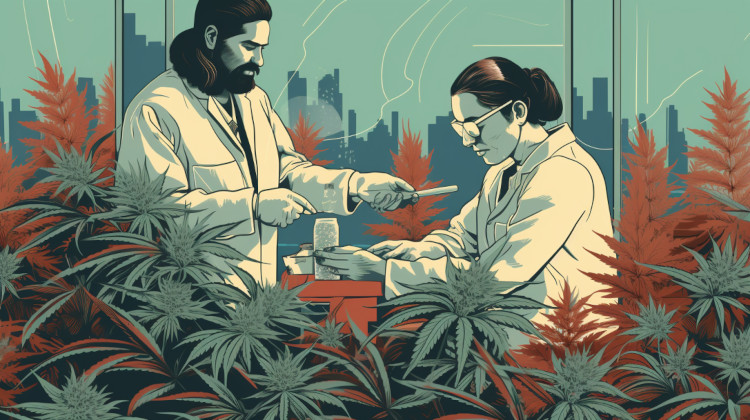In This Article
- Our Hypothesis
- Our Methodology
- Acknowledgments
- Our Findings
- Demographics
- Top 10 Conditions Individuals Are Seeking Cannabis to Treat
- Top Conditions by Age Range
- Top Conditions by Region in the U.S.
- Putting Our Findings in Context
- Medical Cannabis Patients Have Diverse Needs
- The Importance of Additional Research and Patient Awareness Cannot Be Overstated
- Companies and Policies Will Need to Adapt
- Further Study Is Needed
- Benefits of Talking to Your Doctor
- Dosing Considerations
- Conclusion
Millions of Americans are turning to medical cannabis (MMJ) to manage their health conditions. A recent Harris Poll survey found that 91% of cannabis users report they do so for health and wellness purposes. However, despite its growing popularity, a cloud of misinformation surrounds medical cannabis. Skepticism persists about its effectiveness, with some people believing that patients are abusing the system or that obtaining a medical cannabis card is too easy.
NuggMD, the nation's leading medical marijuana technology platform, is uniquely positioned to address these issues. With over 2 million patients connected to state-licensed doctors through our telemedicine platform, we have a wealth of data on why patients seek MMJ recommendations.
This report delves into the reasons people across the US obtained MMJ cards in 2023, exploring variations by state, region, age, and gender. We aim to use these insights to bridge the knowledge gap surrounding medical cannabis.
Through sharing our findings, we hope to empower medical professionals, journalists, and legislators with a clearer understanding of patient needs. This knowledge can inform better practices, policy decisions, and improved access to information and care for current and potential MMJ patients. Furthermore, we want patients to feel seen and supported, knowing they are not alone in their health struggles or their search for reliable information about cannabis as a potential treatment option.
Our Hypothesis
This report seeks to answer critical questions surrounding patient motivations for using medical cannabis:
- Nationally, what are the most common conditions patients seek MMJ for?
- Do these conditions vary by region, age, and self-identified gender?
- How do patient demographics and location influence their reasons for seeking cannabis?
- Are patients comfortable researching medical cannabis as a potential treatment option?
- How do patient comfort levels and variations in qualifying conditions affect doctors' ability to provide optimal care?
We anticipate significant discrepancies in the conditions patients seek to treat with MMJ based on age, gender, and geographic location. This includes not only the qualifying conditions themselves but also the emphasis placed on specific conditions within each state/region. For example, states with robust opioid abuse programs might see a higher focus on chronic pain management with cannabis. In contrast, those with a larger veteran population might see more PTSD diagnoses.
By analyzing our findings alongside supplementary research on regional policies, qualifying conditions, and existing data on condition prevalence and non-cannabis treatments, we aim to:
- Understand the factors contributing to variation in patient motivations.
- Identify areas where information accessibility requires improvement based on patient needs.
- Propose actionable steps for states and organizations to bridge these beneficial knowledge gaps.
Our Methodology
This report leverages data from NuggMD's telemedicine platform, specifically focusing on patient sign-ups from July 1, 2022, to June 30, 2023. This timeframe provides a comprehensive 12-month snapshot of patient motivations for seeking MMJ. We analyzed data from over 167,000 patients across the United States, with ages ranging from 18 to 106.
During the registration process, patients were asked to disclose their reason for seeking medical cannabis. These patients were allowed to choose from the list of their particular state's qualifying conditions or enter a freeform answer. Patients were allowed to select as many conditions as they felt necessary.
To understand potential correlations between demographics and MMJ use, we segmented the data into distinct respondent groups. These groups were based on self-identified gender (male or female), state of residence, and age as documented in pre-evaluation health records. This analysis aimed to identify if specific conditions were more commonly treated with medical cannabis by individuals of a particular gender, age group, or geographic location.
To enhance the context of our findings, we conducted supplemental research. This research focused on conditions exhibiting significant variance by gender, age, or region. Also, it explored broader patterns of patient cannabis use to provide a more comprehensive understanding of our results.
Data in this report may be impacted by higher response rates in select states, such as California and New York. Further research encompassing a wider range of demographics would be beneficial, particularly a larger sample size across all age groups and states. Also, incorporating in-person evaluation data and controlling for variables like detailed demographics could provide a more nuanced picture. These future studies would strengthen the validity of our findings and contribute the most accurate information for individuals, healthcare practitioners, and policymakers.
Acknowledgments
| Anthony Pellegrino Report Author, Writer at NuggMD Alexandra Arnett Report Analyst & Fact-Checker, Lead Medical Researcher at NuggMD University of Maryland School of Pharmacy, Master of Science in Medical Cannabis Science and Therapeutics Deb Tharp Report Review & Editor, Lead Legal Researcher at NuggMD | Dr. Brian Kessler Report Medical Review, Medical Provider and Medical Reviewer at NuggMD Pain Management & Sports Medicine St. George’s University School of Medicine, New York Medical College, Lincoln Hospital Medical Center, Residence in General Surgery Medical License in NY and CA Member of the American Medical Association (AMA) |
Our Findings
Demographics
While our data encompasses patients across the United States, a significant portion (52.93%) came from California, reflecting NuggMD's larger presence in that state. Also, over half of our respondents (56.40%) were 33 years old or younger. These factors may influence the generalizability of our findings to the national population. To address this, we will present breakdowns of our data by age range and state/geographic region throughout this report.
Top 10 Conditions Individuals Are Seeking Cannabis to Treat
This report analyzed data from a large number of medical cannabis patients. Here's a glimpse at the top conditions patients sought treatment for:
Over half (51%) of all submissions indicated anxiety or stress as a primary reason for seeking medical cannabis. Chronic pain is another major reason for seeking medical cannabis, with over 39% of patients reporting it as a qualifying condition. Insomnia was a significant concern for over 30% of patients, suggesting cannabis may be a potential option for individuals struggling with sleep disorders.
A notable finding is the high number of patients (nearly 20%) who listed "Other Conditions" as their reason for seeking medical cannabis.
| Top 10 Conditions Individuals Used Cannabis to Treat in 2023 | ||
| Conditions | Total # of Individuals Seeking Cannabis for the Condition | % of Total Submissions |
| Anxiety | 85,764 | 51.275% |
| Severe or Chronic Pain | 65,577 | 39.206% |
| Stress | 63,026 | 37.681% |
| Insomnia | 50,277 | 30.059% |
| Other Condition | 32,741 | 19.575% |
| Migraines | 32,396 | 19.368% |
| PTSD | 30,476 | 18.221% |
| Nausea | 15,066 | 9.007% |
| Arthritis | 13,609 | 8.136% |
| Muscle Spasms (including, without limitation, spasms caused by multiple sclerosis) | 13,209 | 7.897% |
What We Learned from the Top 10 Conditions
First and foremost, patients often list multiple conditions on their applications. This could be due to genuinely experiencing several ailments or difficulty finding their specific condition on the list (e.g., substituting "severe pain" and "nausea" for conditions such as Ehlers-Danlos or Chron’s in states where they are not qualifying conditions).
The data demonstrates a clear mix of mental and physical healthcare needs. Conditions like anxiety, stress, and PTSD highlight the role of medical cannabis in addressing mental health concerns. On the physical side, chronic pain, migraines, nausea, muscle spasms, and arthritis all emerged as significant reasons for seeking treatment.
The top ten conditions included those more commonly reported by younger patients (anxiety, stress) as well as older demographics (arthritis). Notably, PTSD, while not a top 5 condition in any age group, still ranked within the national top ten. This suggests a potential need for further research on the use of medical cannabis for PTSD.
Nearly one in five patients listed "Other Condition," a significant increase from 2022 (8.74%). This rise could be due to states lacking a defined list of qualifying conditions or allowing doctors more discretion in approvals. However, it could also indicate that some states are restricting access to cannabis for conditions commonly experienced by their residents.
What This Means for Medical Cannabis Patients, Practitioners, and Legislators
This report paints a multifaceted picture of the medical cannabis industry, highlighting areas where stakeholders can work together for a more informed and patient-centered future.
The vast diversity of conditions and demographics among medical cannabis patients emphasizes the need for personalized treatment plans. Patients should prioritize talking to qualified doctors to understand their condition, explore cannabis as a potential treatment option, and determine the best product and dosage for their individual needs.
Doctors play a vital role in guiding patients through the medical cannabis landscape. This report accentuates the importance of staying up-to-date on the latest research and understanding the diverse conditions patients may be treating with cannabis. By working collaboratively with patients, practitioners can create effective treatment plans that prioritize safety and well-being.
Finally, the significant number of patients using cannabis for "Other Conditions" demonstrates the limitations of current qualifying condition lists. Developing standardized lists informed by medical professionals and researchers can improve patient access, reduce stigma, and strengthen the research base for medical cannabis. Additionally, promoting data collection efforts that differentiate between treating a condition and treating its symptoms would further illuminate the true impact of medical cannabis on a wider range of conditions.
Top Conditions by Age Range

While our data skewed younger, with a significant portion (56.40%) of respondents under 33, we still received thousands of responses from each age group. This allows us to explore how the conditions patients seek treatment for vary by age.
- 18-25: This age group exhibited the highest rates of conditions often linked to adolescence and young adulthood, including eating disorders (Anorexia - 88.34%), stress (65.24%), insomnia (64.53%), and anxiety (61.59%). Interestingly, Autism also emerged as a top condition (52.57%) in this group.
- 26-33: Here, we see a shift towards conditions potentially arising from chronic illness or injury. Autism (25.30%) remains a top condition, but it's joined by Irritable Bowel Syndrome (24.14%), Epilepsy (23.50%), and Crohn's Disease (21.89%).
- 34-41: This group continues the trend of chronic conditions, with Hepatitis C (36.40%) emerging as a leading concern. Crohn's Disease (23.40%), Traumatic Brain Injury (22.53%), and Epilepsy (21.08%) remain prevalent. Spasticity (19.06%) also appears as a significant condition.
- 42-49: Similar to the 34-41 age range, Multiple Sclerosis (25.65%) and Traumatic Brain Injury (20.95%) are prominent concerns. Spasticity (20.11%) and Inflammatory Bowel Disease (19.84%) also rank highly.
- 50-57: This age group sees a rise in conditions associated with aging, such as Fibromyalgia (20.16%) and Multiple Sclerosis (18.89%). Notably, chronic medical conditions treated with opioids (18.15%) also appear as a top reason for seeking medical cannabis.
- 58-65 & 66-73: Osteoarthritis (27.80% & 20.85%) and Cancer (21.57% & 23.11%) become leading conditions in these age groups. Additionally, Neuropathy (21.48% & 17%) and chronic opioid use (19.95% & 16.86%) remain significant concerns.
- 74-106: The oldest age group shows a significant decrease in the prevalence of most conditions. However, Glaucoma (11.1%) and Cancer (10.11%) remain relevant concerns, along with Osteoarthritis (9.27%) and Neuropathy (5.82%).
How Conditions Vary by Age Range
The data suggests a clear correlation between age and the reasons patients seek medical cannabis. Younger patients (18-25) were more likely to list conditions often associated with adolescence and young adulthood, such as eating disorders, stress, anxiety, and insomnia. These concerns were absent from the top 5 conditions for any other age group.
As age increases, the focus shifts towards managing chronic health issues. We see a rise in conditions like Inflammatory Bowel Disease, Hepatitis C, Multiple Sclerosis, and Osteoarthritis among patients in their 30s and onwards.
There's also some overlap in conditions across neighboring age groups. For example, Irritable Bowel Disease and Epilepsy appear as the top conditions for patients between 26 and 49 years old. This suggests a need for ongoing care and support as patients with chronic conditions age.
What This Means for Medical Cannabis Patients, Practitioners, and Legislators
Medical cannabis patients have diverse needs based on their age and life stage, suggesting practitioners must move away from a "one-size-fits-all" approach to medicinal cannabis. Instead, they can leverage this information to tailor treatment plans with products and formulations that address patients' specific concerns across different age groups. For example, focusing product development solely on anxiety and insomnia may neglect older demographics who seek cannabis primarily for pain management.
Understanding the most common conditions by age range can illuminate areas where patients require additional support. A Canadian study from 2022 found that participants were self-medicating with cannabis for conditions such as anxiety, insomnia, depression, ADHD, chronic pain, muscle spasms, and irritable bowel disease, suggesting a potential gap between patient needs and existing treatment options. By focusing on conditions with high prevalence in specific age groups, legislators and healthcare providers can work together to identify areas where state and federal programs could offer more comprehensive support.
The data provided in this report also strengthens the case for a broader range of qualifying conditions for medical cannabis use. The high prevalence of "chronic medical condition treated with opioids" in older age groups suggests a need to consider including these conditions in cannabis treatment. Similarly, the significant number of patients with neuropathy, a condition not included in many state's qualifying lists, stresses the need for evidence-based policy updates.
Finally, the inclusion of gastrointestinal (GI) issues in multiple age ranges points to a potential area of unmet healthcare needs in the US. This could inform product manufacturers to prioritize ingredients that address gut health alongside traditional focuses like sleep or pain relief.
Top Conditions by Region in the U.S.

As expected, our analysis revealed variations in top conditions by region. These variations likely stem from a combination of factors, including resident demographics and the specific qualifying conditions listed by states within each region.
- Midwest (IL, IA, MO, OH): Severe chronic pain and "Other Conditions" were the most frequently reported reasons for seeking medical cannabis in the Midwest. The high prevalence of "Other Conditions" could be due to a combination of factors, such as stricter qualifying condition lists in some Midwestern states or patients struggling to find their specific condition listed.
- Northeast (CT, ME, MD, MA, MI, NJ, NY, PA, VT): Similar to the Midwest, severe chronic pain ranked highly in the Northeast. However, this region also saw a significant number of patients seeking treatment for anxiety, potentially reflecting the higher population density and faster pace of life often associated with the Northeast.
- South (TX, GA, OK, LA, VA, WV): Unlike other regions, anxiety emerged as the top condition in the South, followed by chronic pain and insomnia.
- West (CA, MT, NV): The West Coast mirrored the South's top three conditions, with anxiety, stress, and insomnia ranking highest. This alignment might be due to similar demographics or a more established cannabis culture on the West Coast, leading to greater comfort with using cannabis for mental health conditions.
How Conditions Vary by Region and State
Severe or chronic pain emerged as a top 5 condition in every region and state except Texas, where it's not a qualifying condition for medical cannabis. This highlights the pervasiveness of chronic pain as a reason for seeking cannabis treatment across the US.
Anxiety and stress were prominent concerns in all regions except the Midwest, where many states don't list them as qualifying conditions. This suggests a potential link between regional qualifying condition lists and the conditions patients report. PTSD, on the other hand, appeared as a top 5 condition in all regions except the West, where our data skewed younger. This might indicate a growing need for cannabis as a PTSD treatment across different demographics.
The presence of "Other Conditions" as a top 5 reason for seeking medical cannabis in 7 out of 22 states is noteworthy. This could be due to states allowing doctors more discretion in approving patients or limitations in the established qualifying condition lists. In either scenario, it can restrict access for new patients who might benefit from cannabis but are unaware of their eligibility due to a narrow qualifying condition list.
What This Means for Medical Cannabis Patients, Practitioners, and Legislators
A state's qualifying condition list can significantly impact both patient care and the data collected. For example, Texas, where chronic pain isn't a qualifying condition, was the only state where it didn't rank as a top 5 reason for seeking medical cannabis. Similarly, the absence of anxiety as a top condition in the Midwest aligns with many Midwestern states not listing it as a qualifying condition.
The average age of applicants can skew data on top conditions. This can lead to marketing efforts and public awareness campaigns that fail to address the needs of all potential patients, particularly veterans, the elderly, or those with conditions not typically associated with younger demographics. Practitioners and legislators need to be aware of these limitations and advocate for data collection methods that capture the full spectrum of patient experiences.
Regional variations can illuminate areas where patient needs are not being met. For example, the prevalence of "Other Conditions" in some states suggests a gap between qualifying condition lists and patient realities. By understanding these regional variations, legislators and healthcare providers can work together to improve access to medical cannabis for underserved populations.
Putting Our Findings in Context

In this analysis, we've unpacked a wealth of data on medical cannabis use across the United States. We've explored demographics, top conditions by age range and region, and what these variations mean for different stakeholders in the medical cannabis industry. These insights can inform efforts to improve patient care, product development, and access to medical cannabis for a wider range of conditions.
Medical Cannabis Patients Have Diverse Needs
A critical takeaway from this report is the undeniable diversity of medical cannabis patients. Treating this population as a homogenous group is a recipe for ineffectiveness, as it fails to account for the vast spectrum of needs and conditions that drive patients to seek cannabis treatment.
Our data paints a clear picture: patients range from young adults (18-25) to those well over 100 years old. Not surprisingly, the most common conditions reported vary significantly by age group. While younger patients often cite anxiety, stress, and insomnia as primary concerns, older demographics are more likely to seek cannabis for chronic pain, arthritis, or even cancer treatment-related nausea.
Focusing solely on the "big three" conditions of anxiety, pain, and insomnia can overlook the unique needs of older patients. By shifting marketing efforts and product development to prioritize conditions like neuropathy, arthritis, and nausea, the medical cannabis industry can provide a more welcoming and inclusive environment for all patients, regardless of age or condition.
The Importance of Additional Research and Patient Awareness Cannot Be Overstated
The ever-evolving landscape of medical cannabis is underscored by the dramatic rise of autism spectrum disorder (ASD) as a top condition for younger patients (18-33) in our 2023 report. This is a stark contrast to the 2022 data, where ASD wasn't even considered a common qualifying condition.
While one theory attributed this shift to an increase in states recognizing ASD, the data suggests otherwise (only one state added "autism" between 2020 and 2023). A more likely explanation may come in two parts; the first is the increase in the diagnosis of ASD in adults, specifically women, due to more education about the condition. The second part involves the growing body of research exploring the potential benefits of cannabis as a treatment for ASD. This research appears to be influencing both patients and practitioners, leading to a greater willingness to explore cannabis as a treatment option.
This highlights the critical role of ongoing research in shaping patient and practitioner awareness. Quality research not only identifies conditions that may respond effectively to cannabis treatment but also helps guarantee patients aren't using cannabis for conditions where other options might be more appropriate.
Companies and Policies Will Need to Adapt
The widespread use of medical cannabis across all age groups demonstrates the seriousness of the conditions it treats. As more patients integrate cannabis into their treatment regimens, companies and policymakers will need to adapt to guarantee their well-being and protection.
Currently, some states have policies that create a precarious situation for medical cannabis patients. These policies might include termination from employment for off-duty use, loss of child custody based on medical cannabis use, restrictions on firearm ownership, or even ineligibility for organ transplants. While positive changes are underway in some regions, these disparities leave many patients in an impossible bind. They are forced to choose between their health and well-being, risking legal or professional repercussions.
Moving forward, companies and policymakers must prioritize the needs of medical cannabis patients. This includes enacting clear and consistent regulations that protect patients from undue penalties and ensuring access to safe and effective medical cannabis products. By promoting a more patient-centric approach, these stakeholders can contribute to a future where medical cannabis is recognized as a legitimate treatment option and freely accessible to those who can benefit from it.
Further Study Is Needed
While this report offers a comprehensive analysis of medical cannabis use in the United States, we must acknowledge the inherent limitations of our data. A significant portion comes from California, a state with a younger patient demographic. This can skew the national and regional trends we observed.
Future studies should include data from a wider range of states for a more balanced representation of the national landscape. Additionally, segmenting data by age and region in greater detail would provide more granular insights into variations across different demographics and geographic locations.
This study focused solely on NuggMD patients who used telemedicine for evaluations. Further research is needed to explore whether the patient needs to differ significantly between those who use telemedicine and those who receive in-person evaluations.
We invite universities, journalists, non-profit organizations, and all entities studying medical cannabis use to expand on our findings. We are eager to collaborate with these groups to shed further light on how the industry and policymakers can best serve the needs of medical cannabis patients. If you're interested in pursuing further research, please reach out to us. We're committed to supporting efforts that illuminate the evolving landscape of medical cannabis and empower patients to make informed decisions about their health.
Benefits of Talking to Your Doctor
The findings from a recent report highlight the importance of consulting a qualified doctor before considering medical cannabis use. Many patients seek cannabis treatment for diverse conditions, indicating unique needs that may not be addressed by generalized information. With patients ranging from 18 to 106 years old and seeking treatment for a wide range of conditions, personalized guidance from a doctor becomes paramount in navigating this complexity.
A qualified healthcare professional can empower individuals on their medical cannabis journey by providing a thorough understanding of their specific health conditions, including underlying causes and potential treatment options beyond cannabis. They can tailor cannabis treatment plans to suit individual needs, considering factors like age, condition, and other medications to maximize benefits and minimize side effects. Additionally, doctors can offer guidance on dosage to ensure a positive experience and assess potential interactions with other medicines, prioritizing patient safety and optimizing treatment outcomes.
Dosing Considerations
Each person's body chemistry and endocannabinoid system function uniquely. Factors like age, weight, metabolism, and even genetics can influence how cannabis affects you. A dose that works well for one person might be too high or too low for another.
Medical cannabis products come in a variety of forms, each with its own potency and absorption profile. For example, inhaled flower or concentrates may have a faster onset and shorter duration of action compared to edibles.
The optimal dose can also depend on the specific condition you're treating. For chronic pain management and sleep, some individuals may find that a higher dose might be necessary compared to using cannabis for depression or anxiety relief. A doctor or pharmacist can help you determine a starting point and gradually adjust the dose to achieve the desired results.
Due to these complexities, begin with a low dose and slowly increase it (titration) under the guidance of a qualified healthcare professional. This measured approach allows you to identify the dose that best addresses your needs while minimizing the risk of adverse effects.
Conclusion
This report has unpacked a wealth of data on medical cannabis use across the United States. We've explored demographics, variations in top conditions by age range and region, and the implications for different stakeholders in the industry. Several key findings emerge:
Medical cannabis patients represent a broad spectrum of ages and conditions. A one-size-fits-all approach fails to address this diversity. Focusing on age-specific needs and expanding qualifying condition lists can improve access and ensure patients receive appropriate treatment.
Demographics and qualifying condition lists influence the conditions patients seek treatment for. Understanding these variations allows for targeted outreach and product development to serve patients across different regions better.
The overarching message from this report is clear: the more information available to patients, practitioners, and policymakers, the better equipped they are to make informed decisions. Unfortunately, current data availability is limited, and stereotypes around cannabis use skew the information landscape. This report serves as a starting point based on NuggMD's telemedicine patients and limited state coverage. Further research is necessary to verify or refute our findings and illuminate the full potential of medical cannabis for a broader range of conditions and patients.
The information in this article and any included images or charts are for educational purposes only. This information is neither a substitute for, nor does it replace, professional legal advice or medical advice, diagnosis, or treatment. If you have any concerns or questions about laws, regulations, or your health, you should always consult with an attorney, physician or other licensed professional.




